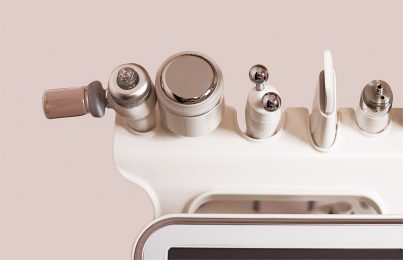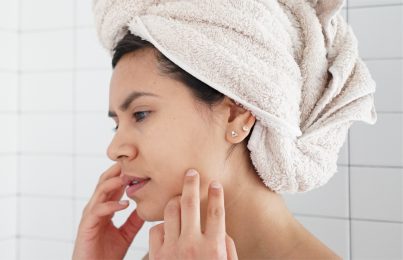With skin care becoming increasingly high-tech, there are more professional treatments out there than ever before. These high-tech treatments can be great additions to your at-home routine if you’re looking to target specific issues. But while it’s great having all these options, it can also be overwhelming at times (not to mention expensive!). A lot of these treatments advertise similar results, so how do you know which one to pick? Which will give you the most bang for your hard-earned buck?
Because it’s so simple and non-invasive, microneedling is a sought-after professional treatment these days. It’s touted as a treatment for many issues, acne scarring included. But is this really the best treatment for acne scars? Could it actually make scarring worse? In this post, I’ll answer these questions and give an overview of this popular procedure.
What is Microneedling and How Does it Work?
Let’s start with the basics. As the name suggests, microneedling is a procedure that uses tiny needles to create small puncture wounds in the skin. The purpose of creating these micro wounds is to trigger your skin’s own healing response, which is pretty powerful. While this may sound scary, microneedling is associated with little to no pain, and a topical numbing cream is applied before a single needle ever touches your face. The procedure is done using a tool called a dermaroller, and needles usually range anywhere from 0.5-3.5 mm in length.
While this procedure can have many benefits, the greatest benefit of microneedling is collagen production. Collagen production is a huge part of your skin’s healing process, so by creating superficial wounds that won’t cause lasting damage, you’re essentially tricking your skin into creating new collagen.

Does Microneedling Help With Acne Scars?
Before I answer this question, I want to clarify the difference between acne scars and hyperpigmentation.
True acne scars leave indents in the skin and are typically caused by severe acne, such as cystic or nodular. These are the kinds of blemishes that don’t come to a head, no matter how much you pick and squeeze (which you really shouldn’t do, btw). Picking and squeezing increases the likelihood that a blemish will leave an atrophic (indented) scar in its wake. These indents are true acne scars and can linger for years, or if they’re deep enough, never resolve.
Post-inflammatory hyperpigmentation (PIH) is the technical term for those dark marks that hang around after a blemish heals. People often talk about PIH and acne scars interchangeably, but for the sake of this post, it’s important to distinguish between the two.
Microneedling for Indented Acne Scars
The good news is that microneedling can absolutely help with indented acne scars. Because it helps stimulate your skin’s own production of collagen, these indents can be filled in overtime, giving the skin an overall smoother appearance. Basically, microneedling helps “plump out” acne scars.
I spoke with my friend Dr. Samuel Lam, a board-certified plastic surgeon at Lam Facial Plastics in Plano, TX, who regularly performs microneedling at his practice. He told me he often uses microneedling in conjunction with radio frequency as a go-to treatment for acne scarring: “For shallower acne scarring, I love radio frequency micro needle. To me, radio frequency microneedling is very important because it helps stimulate the dermis to become thicker and to compensate for atrophic or dented acne scars. I personally believe that microneedling without the stimulation of radio frequency is not as effective. I also go deep with 3.5 mm needles. Usually, it takes a series of three to five to begin to see the improvement.”
Radio frequency also helps build collagen and elastin, but it works on deeper layers of the skin than microneedling to give an overall tighter, firmer more lifted look. When combined with microneedling, radio frequency is able to penetrate more effectively through micro-channels created by the needles.
Microneedling for Hyperpigmentation
I’ve heard of microneedling being recommended for PIH, but I personally don’t believe this to be the best course of treatment. PIH is caused by an excess of melanin—basically, overactive pigment cells have been triggered by the trauma of an inflamed blemish. When this happens, the goal is to get these overactive pigment cells to settle down. Since microneedling is such an active treatment, it can actually have the opposite effect and may keep pigment cells activated longer. Keep in mind that everyone’s skin is different, and getting microneedling isn’t guaranteed to make pigmentation better or worse. That said, if this is your main concern, microneedling isn’t the first treatment I would recommend.
If you’re looking to fade dark marks, you ultimately have to play the long game—it’s all about patience. I know, I know, this is everyone’s least favorite answer! But these marks will go away on their own eventually, so I don’t necessarily recommend spending money on a professional treatment to fade them. That said, there are some things you can do to speed up the fading process.
Can Microneedling Make Acne Scars Worse?
If you have hypertrophic scars (also known as keloids), which are raised scars caused by an overproduction of collagen during the healing process, microneedling is not recommended. Since collagen excess is already the issue, you want to stay away from procedures that trigger further collagen production.
At-Home Treatments for Indented Acne Scarring
While microneedling is a great treatment option for indented acne scars, I understand it’s not available to everyone. Luckily, there are things you can do at home to boost collagen production. Whether or not you’re having microneedling done, adding in one or more of these steps will benefit you.
Topical Treatments
As far as topical treatments go, these are best for building and protecting collagen:
- Retinoids. Retinoids are usually found in prescription-strength products that you’ll need to get from a dermatologist. If your skin is too sensitive for a retinoid, you can look for an over the counter product that contains retinol. Retinol is gentler, but still stimulates collagen production.
- Vitamin C. Look into using a Vitamin C serum during the day. Vitamin C both helps builds collagen and prevents it from being broken down further.
- Exfoliating Acids. Exfoliating acids can help plump the skin by building collagen, but they also help give the skin a more even-textured appearance by “sanding down” the top layers of dead skin cells.
- Sunscreen. The sun’s rays contribute to the breakdown of collagen more than any other external factor, so wearing a broad-spectrum sunscreen every day is crucial.
Although all of these can help minimize the appearance of indented acne scars, keep in mind that you can’t expect the same results from topical products as from a professional treatment. It’s important to manage your expectations and be wary of any company that claims it will make your acne scars disappear with a single product.
Read: More Ways to Smooth Indented Acne Scars
What About At-Home Microneedling?
Thanks to social media, you may have already noticed that at-home microneedling devices like dermarollers and dermapens have taken off. I’ve seen so many videos on Instagram of people blissfully rolling needles across their faces, and it makes me cringe every time. I strongly believe microneedling of any kind should be left to professionals—there’s so much potential for damaging your skin, it’s just not worth it.
Read: Ten At-Home Skincare Devices to Start and Stop Using Now
Bottom Line
With so many high-tech options available for treating acne scarring, it’s important to schedule a consultation with a skincare professional who is well-versed in all these treatments. They will be able to examine your skin and suggest personalized treatment options. That said, I believe microneedling is well documented as an effective treatment for indented acne scarring, especially when combined with other therapies like radio frequency. It’s definitely a treatment worth looking into!
Celebrity Esthetician & Skincare Expert
As an esthetician trained in cosmetic chemistry, Renée Rouleau has spent 30 years researching skin, educating her audience, and building an award-winning line of products. Her hands-on experience as an esthetician and trusted skin care expert has created a real-world solution — products that are formulated for nine different types of skin so your face will get exactly what it needs to look and feel its best. Trusted by celebrities, editors, bloggers, and skincare obsessives around the globe, her vast real-world knowledge and constant research are why Marie Claire calls her “the most passionate skin practitioner we know.”




Comments:
I am so thankful for this post! I have long been suffering with terrible acne and unfortunately at it’s worst the acne left indented scars as a result. I consulted a dermatologist a few months back about the best choices to help eliminate this scaring and was left with little to no hope at all. I am realistic in knowing they may never fully go away but to see them change for the better even slightly would be a joy to my soul! Thank you for sharing your knowledge with us all. I have read many of your post already (and plan to read them all). I’d love to go back to school to be an esthetician considering I could have such a passion for it and share the struggles many clients would have. Fingers crossed! Once again, thank you so much! You are a difference maker and are so inspiring! Keep it up!
Posted By: Michelle |
Thank you for your kind words! So glad you found this post helpful <3
Posted By: Renée Rouleau |